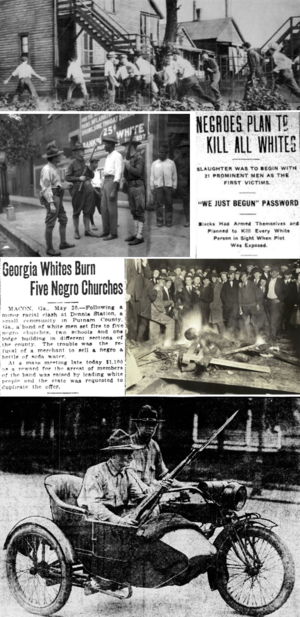
Back الصيف الأحمر Arabic Qırmızı yay Azerbaijani Estiu Vermell Catalan Rudé léto Czech Κόκκινο Καλοκαίρι (1919) Greek Verano Rojo de 1919 Spanish تابستان قرمز Persian Été rouge French הקיץ האדום HE 赤い夏 Japanese
| Part of the First Red Scare and nadir of American race relations | |
 (clockwise from the top)
| |
| Date | 1919 |
|---|---|
| Location | United States |
| Target | African Americans |
| Participants | Mostly white mobs attacking African-Americans |
| Outcome | White supremacist terrorist attacks, riots, and murders against black Americans across the United States |
| Deaths | Hundreds |
| Inquest |
|
| Part of a series on the |
| Nadir of American race relations |
|---|
 |
Red Summer was a period in mid-1919 during which white supremacist terrorism and racial riots occurred in more than three dozen cities across the United States, and in one rural county in Arkansas. The term "Red Summer" was coined by civil rights activist and author James Weldon Johnson, who had been employed as a field secretary by the National Association for the Advancement of Colored People (NAACP) since 1916. In 1919, he organized peaceful protests against the racial violence.[1][2]
In most instances, attacks consisted of white-on-black violence. Numerous African Americans fought back, notably in the Chicago and Washington, D.C., race riots, which resulted in 38 and 15 deaths respectively, along with even more injuries, and extensive property damage in Chicago.[3] Still, the highest number of fatalities occurred in the rural area around Elaine, Arkansas, where an estimated 100–240 black people and five white people were killed—an event now known as the Elaine massacre.
The anti-black riots developed from a variety of post-World War I social tensions, generally related to the demobilization of both black and white members of the United States Armed Forces following World War I; an economic slump; and increased competition in the job and housing markets between ethnic European Americans and African Americans.[4] The time would also be marked by labor unrest, for which certain industrialists used black people as strikebreakers, further inflaming the resentment of white workers.
The riots and killings were extensively documented by the press, which, along with the federal government, feared socialist and communist influence on the black civil rights movement of the time following the 1917 Bolshevik Revolution in Russia. They also feared foreign anarchists, who had bombed the homes and businesses of prominent figures and government leaders.
- ^ Erickson, Alana J. 1960. "Red Summer." Pp. 2293–94 in Encyclopedia of African-American Culture and History. New York: Macmillan.
- ^ Cunningham, George P. 1960. "James Weldon Johnson." Pp. 1459–61 in Encyclopedia of African-American Culture and History. New York: Macmillan.
- ^ The New York Times 1919.
- ^ Public Broadcasting Service (PBS) 2018, p. Part 3.
© MMXXIII Rich X Search. We shall prevail. All rights reserved. Rich X Search